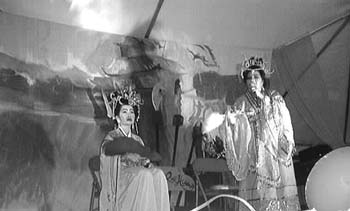Tet Meets West
Vietnam vets, beauty queens share the stage with tradition
By J. Douglas Allen-Taylor
Almost everybody stops for a moment to look at the row of pictures at the Disabled Veterans booth at the Vietnamese New Year Festival at the Santa Clara County Fairgrounds. The men in the pictures stare back sad-eyed and somber. Most of them have lost at least an arm or a leg, some of them more than one. Some sit in pairs or more, balancing on stools, posing awkwardly. One or two have obviously been blinded. Almost all of the visitors to the booth are Vietnamese. Almost none of them have anything to say. They simply look for a moment and then fish into their pockets or purses and drop a dollar into the box labeled "Disabled Veterans & Widows of Former ARVN [Army of the Republic of Vietnam]." A well-to-do-looking middle-aged woman with a dark fur coat slips in a handful of bills. She hides her expression behind dark glasses.
Many of the activities of this year's Santa Clara County Tet Festival were political--geared toward rallying opposition to the current government of Vietnam or raising money for veterans of the 30-year war in Vietnam that ended with the fall of Saigon in 1975. According to the moderating group of the soc.history.war.vietnam newsgroup, more than 300,000 ARVN soldiers sustained permanent 30 percent disability in the war. Another 3,000 to 4,000 suffered 100 percent disability: blindness or the loss of a limb. Reportedly, they get little government assistance either from the present Vietnam government (which they fought against) or from the United States government (which they fought alongside as allies).
Tet Nguyen Dan is the Vietnamese Lunar New Year Festival, celebrated at the same time as the Chinese New Year. More than 30,000 visitors attended the 16th annual Santa Clara County Tet Festival this year, the largest such celebration outside of Vietnam itself. The event is sponsored by the Coalition of Nationalist Vietnamese Organizations of Northern California, which consists of 42 member groups.
"We're not trying to make money with the festival," says coalition general secretary Hung Lai, a customer engineer with Hewlett-Packard. "We're just trying to get people together." He says that the coalition, formed in 1977, promotes both cultural and political activities for the estimated 80,000 to 90,000 Vietnamese immigrants in Santa Clara County. "Politically, we register people to vote and involve ourselves with candidates who wish to do the right thing for our people and our country." Lai describes the coalition as "anti-communist; we are opposed to the present government in Vietnam."
In many ways, the festival was a display of the sometimes uneasy clash-and-blending of Vietnamese and Western cultures.
Among a crowd at a Vietnamese opera on one of the side stages, two teenage girls in hip-hugger jeans and bare-midriff blouses watched quietly while two older women sang and performed in long, elaborately tailored gowns and brightly colored headdresses. It was difficult to tell why the two girls were there. Curiosity, perhaps. Or out of respect. Or perhaps it was an obligatory stop, like getting a cup of gumbo at a Cajun festival. Eventually, after whispering to each other, the two girls walked away toward the CD store booths blaring Asian rock music, carefully avoiding the equally loud karaoke tent. B-boys in backwards baseball caps and baggy pants tapped their feet to the rolling drums of the traditional Dragon Dance. Along the row of restaurant booths, caterers of Vietnamese dishes competed against the regular fairgrounds vendors of hot dogs and cotton candy. At one booth displaying noodles and egg rolls and kabobs, a hand-lettered sign proclaimed "Buy From Us! We're Vietnamese!!"
But in other ways, the festival showed how widely differing cultures end up displaying the same human characteristics.
While fireworks boomed in the sky outside, two elderly men huddled in a deserted end of one of the halls and matched wits at a Vietnamese board game. It looked a lot like checkers but was played on the corners of the squares rather than in the middle. One of the men stood over the board like a great hovering hawk, muttering to himself while his opponent pondered a move and slamming his piece down on the board as soon as his turn came. The other man was frail and withered, tapping his foot so hard that it shook his whole body, and he had to take care not to scatter the pieces when he touched them. He seemed almost obsessively intent on getting one piece to one spot in the middle of the board, to the degree that he dropped six pieces behind trying to attain his goal. He must have known what he was doing. Within a few moves after he got to his spot he won, and his opponent growled and cleared the board with a wave of his hand. The frail man never stopped tapping his foot and never stopped shaking while his opponent set up the board again and complained loudly. The frail man fingered his pipe and finally allowed himself a small flitter of a smile.
[ San Jose | Metroactive Central | Archives ]
Copyright © Metro Publishing Inc. Maintained by Boulevards New Media.
![]()

From the February 5-11, 1998 issue of Metro.
![[Metroactive Features]](/features/gifs/feat468.gif)